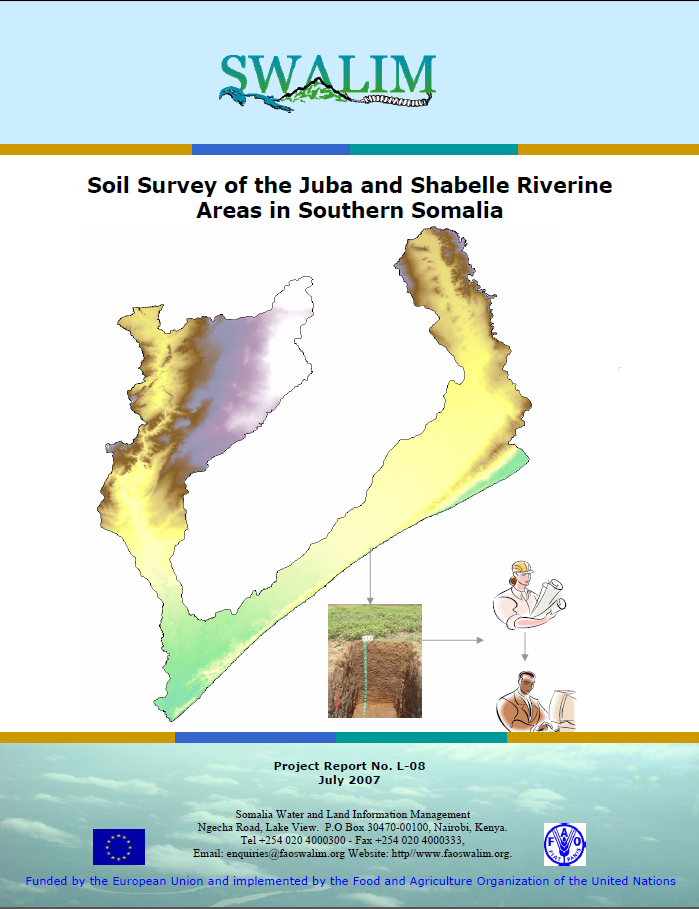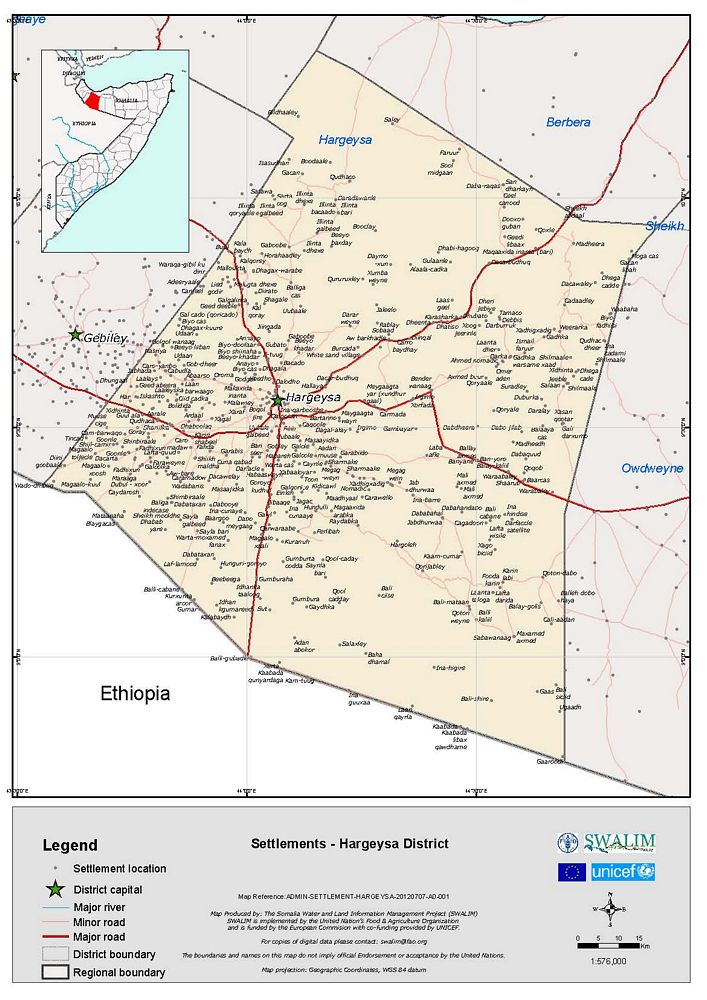Library Catalog
Latest Documents and Publications listed. Use search terms in the box below to find what you need
W-20 Sahan Biyo-jooloiyeed iyo Qiimayn Meelo laga Doortay Gudaha Soomaaliland iyo Puntland
Warbixintani waxay muujinaysaa qiimayn la sameeyey sanadkii 2011/2012 si loo ogaado biyaha kayd oo ka jira dhulka-hoose ee gudaha Soomaaliland iyo Puntland. Warbixintu waxay bixinaysaa faahfaahino ah xog ururinta iyo falanqaynta ay ka mid yihiin: - sahanno jooloiyadeed iyo oogo-dhuleed (geological and geophysical field surveys) oo geyiga duurka ah; iyo falanqayn xog jeedaalin dareeme fog (remote sensing data), iyo sidoo kale waxyaabo kala duwan oo laga soo saaray sahanka/qiimaynta.Waxsoosaarka sahanka biyo-jooloiyeed (hydrogeology) waxaa ku jira waxyaabo kale oo ku dhex jira: biyo-jooloiyeed iyo tayada biyaha Somaliland iyo Puntland oo heerka cabirku yahay 1: 750,000; khariidado hydrogeology ee 4 aagag oo la danaynayo oo qiyaasta cabirku tahay 1: 250,000; Warbixinta weyn ee qiimeynta iyo 4 lifaaq oo bixinaya faahfaahinada shaqada duurka, geophysics, jeedaalin dareeme fog iyo gundhig-xog. Warbixinta waxaa la filayaa inay isticmaalaan daneeyeyaal kala duwan ee waaxda biyaha, badanaa maamullada biyaha Somaliland iyo Puntland ee horumarinta iyo maaraynta khayraadka biyo-dhul-hoose ee gudaha gobolka.
Publication Type:
Technical report
Publication Date:
Author:
Corporate Author:
W-20 Hydrogeological Survey and Assessment of Selected Areas in Somaliland and Puntland - Report No W-20
This report documents an assessment carried out in 2011/2012 to identify potential groundwater aquifers in Somaliland and Puntland. The report gives details of the data collection and analysis including:- desk studies; geological and geophysical field surveys; and remote sensing data analysis, as well as various products generated from the survey / assessment. The products of the hydrogeology survey include among others: hydrogeology and water quality maps of Somaliland and Puntland at a scale of 1:750,000; Hydrogeology maps for 4 selected areas of interest at a scale of 1:250,000; main report of the assessment and 4 appendices giving details of the field work, geophysics, remote sensing and databases. The report is expected to be used by different stake holders in the water sector, mainly the water authorities in Somaliland and Puntland for development and management of groundwater resources in the region
Publication Type:
Technical report
Publication Date:
Author:
Muthusi F.M., Gadain H.M., Somalia Water and Land Information Management, Nairobi (Kenya) - SWALIM
Corporate Author:
SWALIM
W-21 Saamaynta Cimiladu ku leedahay Khayraadka Biyaha Soomaaliland iyo Puntland
Aqoonsi, qiimeyn iyo horumarin khayraad biyo-dhul-hoose ayaa hadda mudnaan degdeg ah u leh gargaarga degdeg ah iyo horumarinta muddo dheer gudaha dhamman dalalka Geeska Afrika oo ay saamaysay abaar iyo biyo yaraan. Sida jawaab u ah arrintaan, UNESCO, bishii May 2012, waxay bilawday hindisaha “Xoojinta Awoodda si gudaha Geeska Africa loogala dagaalamo Abaar iyo Macluul: Soo bixinta Khayraad Biyo-dhul-hoose si loo helo biyo gurmad degdeg” taasoo ay Dowladda Japan taageero ka geysanayso. Mashruucu guud ahaan wuxuu higsanayaa in la khariidadeeyo abaar-u-adkeysiga khayraadka biyo-dhul-hoose ee gudaha meelaha ay dhibaatadu saameysey iyo xoojinta awoodaha goboleed si loo maarayo biyo-dhul-hoose oo abaar-u-diyaargarow u dhaco.
Si looga faa'iidaysto shabakadda la dhisay iyo qotada khibrad hawl-la-wadaagta UNESCO ee FAO-SWALIM (Maareynta xogta biyaha iyo dhulka Soomaaliya) gudaha Soomaaliya, ayaa la rasmiyeey heshiis iskaashi oo dhexmaray UNESCO-FAO kaasoo qeexaya qaabka-shaqo ee mashruuca guud ahaan. Iyadoo mashruucan ka qayb ah, SWALIM waxay dhawaan dhamaystirtay sahan biyo-jooloiyadeed (hydrogeological) iyo qiimayn aagag dhul laga xushay Somaliland iyo Puntland kaas oo uu ka soo baxay macluumaad waxtar ah oo ku saabsan khayraad biyo-dhul-hoose ee la heli karo kaas oo ku biirsamaya hawlahii hore ee SWALIM ee maareynta macluumaadka kheyraadka biyaha iyo dhulka Soomaaliya.
Publication Type:
Technical report
Publication Date:
Author:
Corporate Author:
RSM-02 Odorosid Meelo Dhulbeereed ah Bartamaha iyo Koonfurta Soomaaliya iyadoo loo isticmaalayo Jeedaalin Dareeme Fog
Soomaaliya inta badan waa dal kulul oo oomane iyo yara-oomane isugu jira oo xaddiyada celceliska roobabku u dhaxayo 50 iyo 500 - 600 mm sandkiiba (inkasta oo meelaha qaarkood ay heli karaan xaddi ka yara sareeya). Si loo bixiyo qiyaas koowaad ee dhulka la beeran karo, daraasaddan waxay falanqeysay masawrirro dayax-gacmeed ASTER ah (oo meesha aan la heli karin, waxaa la isticmaalay masawirro kale oo bayaansanaan dhexdhexaad leh) ee sanadkii 2010 iyo 2011 si loo soosaaro akhbaar ku saabsan waxbeerashada gudaha bartamaha iyo koonfurta Soomaaliya. Natiijooyinka daraasadan waxay saldhig u ahaan doonaan falanqayn isxigxigta, aadna u hufan oo ay ku jiri doonaan qaabab namuunado loo soo guro iyo soo xaqiijinta xaalka duurka (iyada oo la adeegsaday shaqaale gurmad degdeg ee FAO iyo kormeerayaal FSNAU ka tirsan) si loo ogaado awoodda waxsoosaarka dhulka iyo qiyaasta waxsoosaar hababka beerashada kala duwan ee heerar beeralay iyo heer degmo.
Publication Type:
Technical report
Publication Date:
Author:
Corporate Author:
RSM-02 Estimating Cultivable Areas in Central and Southern Somalia using Remote Sensing
Somalia is largely a hot, arid and semi-arid country with rainfall amounts averaging between 50 and 500 - 600 mm per annum (even though some areas may receive slightly higher amounts).To provide a first estimate of the cultivable land, this study analyzed ASTER satellite images (and where not available, other medium resolution images) for 2010 and 2011 to generate information about cultivation in central and southern Somalia. The results of this study will be the basis for a successive, more accurate analysis which will include sampling approaches and field validation (through FAO emergency staff and FSNAU monitors) in order to establish the potential cultivable land and estimate production for the different cropping systems at farmer and district levels.
Publication Type:
Technical report
Publication Date:
Author:
Oduori S. M., Oroda A.S., Gadain H.M.
Corporate Author:
Somalia Water and Land Information Management, Nairobi (Kenya)
L-08 Soil Survey of the Juba and Shabelle Riverine Areas in Southern Somalia
Soil information is a key element for natural resources planning. A key output of this study is a soil map with a scale of 1:100, 000 containing the major soil types as well as soil maps for some of the irrigation projects along the Juba and Shabelle river catchments. Further, the report contains information on soil physical and chemical properties, which are key elements for natural resource management. Soil spatial variability is described for an area of approximately 88,000 km2 in the Juba and Shabelle riverine areas in Southern Somalia. This study is essential for carrying out land suitability and land degradation assessments
Publication Type:
Technical report
Publication Date:
Author:
Corporate Author:
L-08 Shan Ciid ee Meelaha Gosha Webiyada Juba iyo Shabelle gudaha Koonfur Soomaaliya
Macluumaad ciid waa wax muhiim u ah qorshaynta khayraad dabiiciyeed. Waxsoosaar muhiim ah ee daraasadan waa khariidad ciideed leh baaxad ah 1: 100, 000 ay ku jiraan noocyada ciidda u badan iyo sidoo kale khariidado ciid ee qaar ka mid ah mashaariicda waraabka ee jiidda biyo qabadyada Webiga Juba iyo Shabeelle. Intaas waxaa dheer, warbixinta waxaa ku jira macluumaad ku saabsan sifooyin oogada iyo kiimikada ciidda, kuwaas oo ah waxyaabo muhiim u ah maareynta khayraad dabiica. Kala duwaanshiyo masaaxad ciideed ayaa laga faaleeyey oo ku dhow 88,000 km2 gudaha dhulka gosh Webiyada Jubba iyo Shabeelle ee koonfurta Soomaaliya. Daraasadani waxay muhiim u tahay in la fuliyo qiimeyno ah haboonaanshiyo dhul iyo xaaluf dhul.
Publication Type:
Technical report
Publication Date:
Author:
Corporate Author:
District Administrative - Hargeysa
these are maps that show the general administrative boundaries of Somalia (National, Regional and District administrative boundaries) as well as settlements, towns, rivers, roads and other general geo-information.
Publication Type:
Map
Publication Date:
Author:
Somalia Water and Land Information Management, Nairobi (Kenya) - SWALIM
Corporate Author:
Assessment of Charcoal Driven Deforestation Rates in a Fragile Rangeland Environment in North Eastern Somalia Using Very High Resolution Imagery
Multi-temporal very high-resolution satellite images and field work have been used for quantifying the tree cutting rate over a 5 years period in a very arid tiger bush area of North Eastern Somalia with intensive charcoal production activities. By applying both a classical area frame sampling approach with visual interpretation of the samples and a semi-automatic tree detection algorithm, it was possible to create baseline tree density layers for the 2 years of observation and to quantify the tree cutting rates for the period from 2001 to 2006. An average annual tree loss of −2.8%, coupled with the total absence of regrowth during the 5 years study period, confirm the tremendous ecological impacts of charcoal driven tree cutting on tiger bush vegetation. Analysis of the results evidences spatial and temporal patterns in the cutting locations and poses the basis for a better understanding of the ecological and human dimensions of deforestation in the fragile rangeland environment of Northern Somalia.
Publication Type:
Journal Article
Publication Date:
Author:
Oduori S. M., Rembold, Vargas R .R., Abdulle
Corporate Author:
A Framework for National Assessment of Land Degradation in the Drylands: A Case Study of Somalia
Land degradation is a gradual, negative environmental process that is accelerated by human activities. Its gradual nature allows degradation to proceed unnoticed, thus reducing the likelihood of appropriate and timely control action. Presently, there are few practical frameworks to help countries design national strategies and policies for its control. The study presented here developed a framework for the national assessment of land degradation. This framework is envisaged to support governments in formulating policies on land degradation. It uses time-series remote sensing data to identify the rate and extent of land degradation, local experts to identify prevalent degradation types and drivers of the degradation and field observations to validate the overall assessment.
Its simplicity, use of freely downloadable input data and self-triangulation of the assessment methods make it suitable for rapid assessment of land degradation on a national scale. It was tested in Somalia, where it exhibited accuracy greater than 60 per cent when assessing land degradation. This framework is relevant for designing national strategies and policies that address land degradation and provides an opportunity for accurate identification of areas to target with comprehensive local assessment. Testing of the framework in Somalia showed that about one-third of the country was degraded because of loss of vegetation cover, topsoil loss and to the decline of soil moisture. Overgrazing, excessive tree cutting and poor agronomic practices in agricultural areas were identified as the primary drivers of the country’s land degradation. These drivers are encouraged by the prevailing communal land tenure practices, poor governance and civil war. Copyright © 2011 John Wiley & Sons, Ltd.
Publication Type:
Journal Article
Publication Date:
Author:
Omuto C, Alim M.S
Corporate Author:
SWALIM
Pages
 RSS feed [compliant with the Agris AP] |
RSS feed [compliant with the Agris AP] |  Agris AP XML
Agris AP XML




